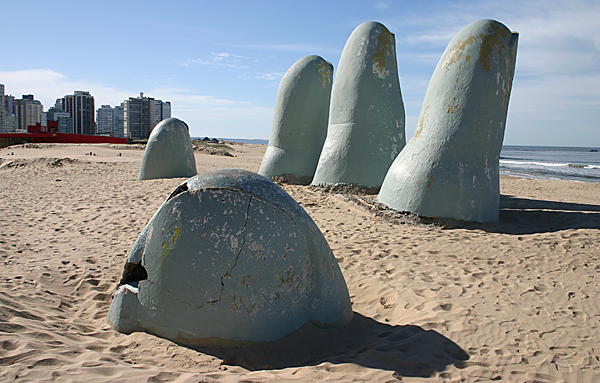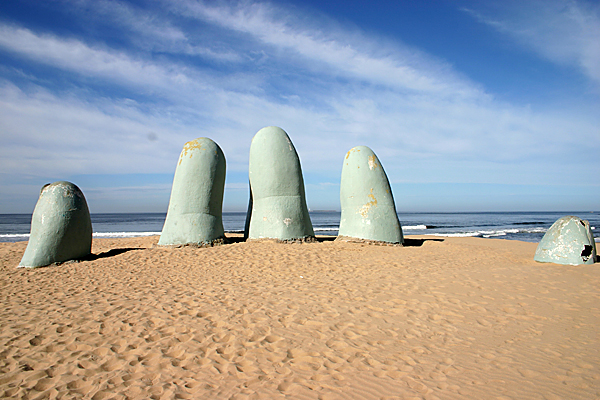Note: This article pertaining to A Day in Punta del Este in Uruguay was originally published on Sunday, August 10, 2014 at 3:55 in the morning and has been updated.
As I drove east from Montevideo on the Ruta Interbalnearia, it astounded me as to how many pedestrians and animals — as well as unsupervised children playing with their toys and bicycles — unabashedly treated the somewhat limited-access highway as though it was their own sidewalk or playground, seemingly oblivious to the occasional motor vehicle which sped by them.
A Day in Punta del Este in Uruguay
I needed to be extra alert and careful while heading towards the resort town of Punta del Este, which is located approximately 134 kilometers east of Montevideo at the southernmost point of Uruguay and defines where the Rio de la Plata officially ends at the Atlantic Ocean. Driving at highway speeds was a relief once I reached what I considered to be relatively open road — and the road was well-paved. The duration of the automobile trip is approximately two hours; and I arrive during the off-season greeted by weather which was sunny and pleasant — but not conducive to a typical beach day.

The car which I rented was the only vehicle parked in the parking lot for the Playa Brava, which is a beach that faces the Atlantic Ocean. The town was desolate with many establishments closed; but I tried to imagine the throngs of crowds which supposedly descend onto this beach during the summer season. As I passed a closed refreshment stand — which looked more like it was abandoned — I walked onto the sand to see perhaps the most famous and recognizable landmark of Punta del Este.

Known as the Monumento de los Dedos or the Mano de Punta Del Este — the Monument of the Fingers or the Hand of Punta del Este respectively — Mario Irarrázabal created this sculpture of concrete and plastic reinforced with steel during the summer of 1982.

His work of art is meant to warn swimmers from drowning in the rougher surf at La Barra further down the beach. The “middle finger” is approximately three times the height of an average person.

Unfortunately, some of the concrete was cracked or missing when I visited — especially on the thumb.

Also in 1982, a small altar located further south along the coastline was inaugurated containing a painted wood sculpture of a virgin — created by Lazo, who was its sculptor — called the Virgen de la Candelaria. It is protected from the elements by glass in its brick arch enclosure.

A popular attraction is the Faro de Punta del Este — a lighthouse in which you may climb up approximately 45 meters using 150 steps to reach the balcony near the top where the crystal prisms brought from France for the illumination system are located. This landmark from November of 1860 was built by Tomás Libarena and created with a mixture of volcanic sand from Rome — which is considered to be harder than cement. It is located at Calle 2 de Febrero approximately four blocks north of the southernmost tip of Punta del Este. During the off-season, parking was absolutely no problem at all.

Drive northeast along the southeastern coast of Punta del Este along the Rambla Lorenzo Batlle Pacheco — which also has a designation of route 10 — approximately four miles or so; and you will be treated to the Maldonado Bridge, which was constructed as a stressed ribbon bridge. Driving over this unusual bridge is strange — as if over a tame version of the back of a Bactrian camel — and the bridge itself seemed rather impractical to me, as only small boats can pass underneath it. Still, I believe that it is worth seeing and driving over at least once.
Other attractions and sights are available in Punta del Este in which you can participate. For example, the Casa del Pueblo is a modern art museum which you may visit.

You can take a boat ride of eight kilometers to Isla de Lobos, which is a nature reserve that is home to one of the largest sea lion colonies in the world. Be prepared to spend at least a couple of hours and up to $80.00 per person with everything included — and that is in United States Dollars.
Final Boarding Call
Expect meals at restaurants in Punta del Este to be more expensive than those found in Montevideo and Colonia del Sacramento — even during the off-season.
Punta del Este is a good day trip if you happen to be in Montevideo and have the time to spend. I do not know about visiting during the summer season when it is most popular — generally particularly during the months of December, January, and February — but when I visited, it was rather peaceful and quiet with no crowds whatsoever.
All photographs ©2014 by Brian Cohen.

